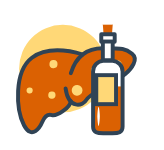.webp)
Article summary
Topic
We owe a lot to a healthy, well-functioning liver, but we often overlook the various negative factors to which we expose our liver. Factors damaging liver cells (hepatocytes) include hectic lifestyle, unbalanced diet, lack of sport activity and “sitting” job, alcohol, viruses, certain drugs, toxins in food such as molds, heavy metals, and abnormal products of metabolism.1
WE OWE A LOT TO A HEALTHY, WELL- FUNCTIONING LIVER
Drugs and the liver
Most drugs are metabolized by the liver, where they are inactivated and detoxified.2 More than 1,000 drugs and herbal products can cause toxic liver damage.4
There is a group of drugs called hepatotoxic drugs1 (with for example popular paracetamol among them) with potentially toxic effects on liver cells.
Factors predisposing to toxic liver damage include:
- genetic factors (inheriting certain genetic mutations that affect the production and action of the liver enzymes that break down toxins may make you more susceptible to toxic hepatitis),
- age (with getting older your liver breaks down harmful substances more slowly, which means that toxins and their by products stay in your body longer),
- gender (men are more sensitive to certain drugs),
- nutritional status,
- simultaneous exposure to several drugs,
- liver disease which is unrecognized at the time of a therapy that harms this organ.3
Alcohol and the liver
Alcohol is the most common cause of liver diseases in developed countries. Poland ranks above the average alcohol consumption calculated among the Organisation for Economic Cooperation and Development (OECD) countries, which is 9.1 litres per adult in a year.5
The habit of drinking a glass of wine or beer every day in the evening can also be a threat to our liver. Liver diseases caused by alcohol abuse include:6
Around 60-90% of people with alcoholic liver disease and over 90% of alcoholics have fatty liver.6
Accelerate liver regeneration with Phospholipids (Essentiale® Forte P)
%20(1)%20(1).webp)
Diabetes and the liver
Diabetes is a chronic disease which occurs when the pancreas does not produce enough insulin (a hormone controlling blood glucose levels) or if the body cannot properly use the insulin it produces.
The World Health Organization (WHO) estimates the proportion of the Polish population with diabetes at approximately 9.5%, which translates into more than 3.6 million patients.8
Both types of diabetes, type 1 and type 2, lead to vascular complications and changes in liver functioning. It is estimated that diabetes leads to liver damage in about 28-39% of cases.9
It occurs due to:
- disorders of carbohydrate metabolism with excessive glycogen accumulation (the liver plays a unique role in controlling carbohydrate metabolism by maintaining glucose concentrations in a normal range),
- abnormal fat metabolism and excessive fat accumulation (which can lead to NAFLD),
- pathologies involving the gallbladder and bile ducts (the ducts that carry bile from the liver to the duodenum).
However, the most common cause of abnormal laboratory test results which check liver functioning in diabetic patients is non-alcoholic fatty liver disease (NAFLD).
Excessive weight or obesity are not good for the liver
Liver diseases are mainly associated with high alcohol consumption. However, one of the biggest enemies of this organ right now are excessive weight and obesity, caused by an unbalanced and fat-laden diet and lack of physical activity. The number of overweight and obese people has increased alarmingly in the last 20 years. In addition to an increased risk of developing type 2 diabetes, hypertension, and lipid disorders, being overweight also has adverse effects on the liver.10
Lipids and the liver
When we gain weight, excess lipids accumulate in hepatocytes, leading to fatty liver and ultimately liver damage.
The combination of poor eating habits and lack of exercise is therefore a real and serious threat to our liver.
Non-alcoholic fatty liver disease (NAFLD) is now the most common liver disease in developed countries and its prevalence is observed in all age groups.
Learn more about NAFLD and the risks associated with it in our article.
You might also like this
- Wawrzynowicz-Syczewska M. Marskość wątroby. Medycyna Praktyczna.http://gastrologia.mp.pl/choroby/watroba/50969,marskosc-watroby – DOA: 25.10.2016.
- Maśliński S, Ryżewski J. Patofizjologia. Wydanie IV uaktualnione. 2009: 796–808.
- Boroń-Kaczmarska A. Polekowe uszkodzenie wątroby. Medycyna Praktyczna. http://gastrologia.mp.pl/choroby/watroba/50955,polekowe-uszkodzeniawątroby – DOA: 25.10.2016
- Szczeklik A. Choroby wewnętrzne. Podręcznik multimedialny oparty na zasadach EBM. Ed. 1, reprint III. Kraków 2005; 922.
- World Health Organization – Diabetes country profiles, 2016.
- Global report on diabetes. Diabetes country profiles – Poland. World Health Organization 2016. http://www.who.int/diabetes/country-profiles/pol_en.pdf?ua=1. DOA: 02.08.2017.
- Kosmalski M. Niealkoholowe stłuszczenie wątroby z cukrzycą typu 2 –niedoceniony problem kliniczny, 25 lutego 2020, NR 21 https://www.kardiologia-i-diabetologia.pl/artykul/niealkoholowe-stluszczenie-watroby-z-cukrzyca-typu-2-niedoceniony-problem-kliniczny.
- Drągowski P., Czyżewska U., Cekała E., Lange P., Zadykowicz R., Sójka A., Brzezińska J., CUKRZYCA JAKO PROBLEM SPOŁECZNY I EKONOMICZNY, Polski Przegląd Nauk o Zdrowiu 2 (39) 2014.
- Szymborska-Kajanek A. et al. Stłuszczenie wątroby. Problem zdrowotny u chorych na cukrzycę typu 2? Przew Lek 2007; 4: 36-42.
- Brończyk-Puzoń A., Koszowska A., Nowak J., Dittfeld A., Bieniek J., Epidemiologia otyłości na świecie i w Polsce, Forum Zaburzeñ Metabolicznych 2014, tom 5, nr 1, 1–5.
- Habior A., Niealkoholowa stłuszczeniowa choroba wątroby a otyłość, Postępy Nauk Medycznych, tom 26, nr 5B, 2013.



